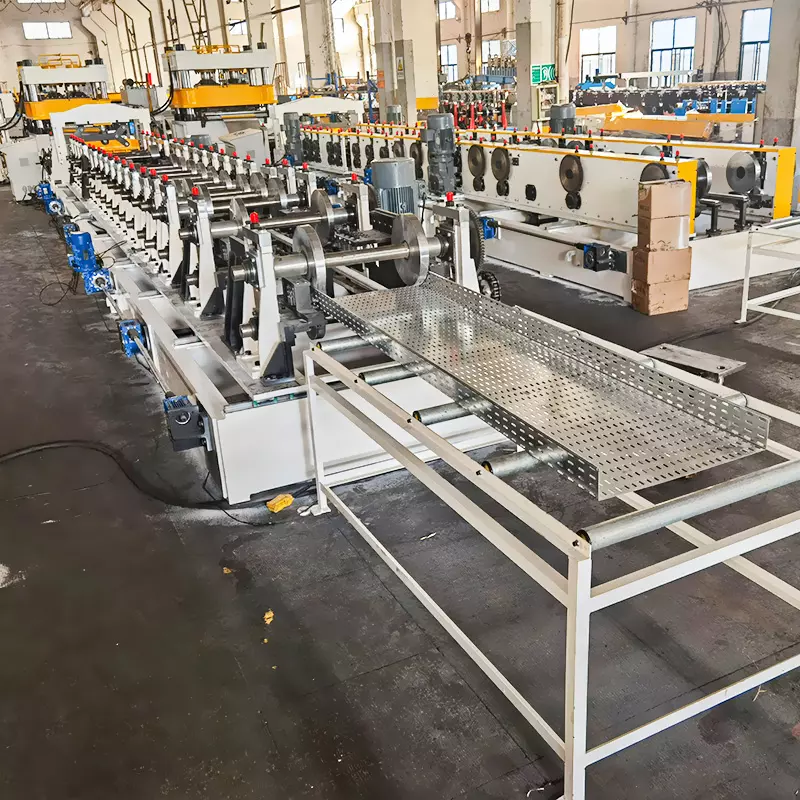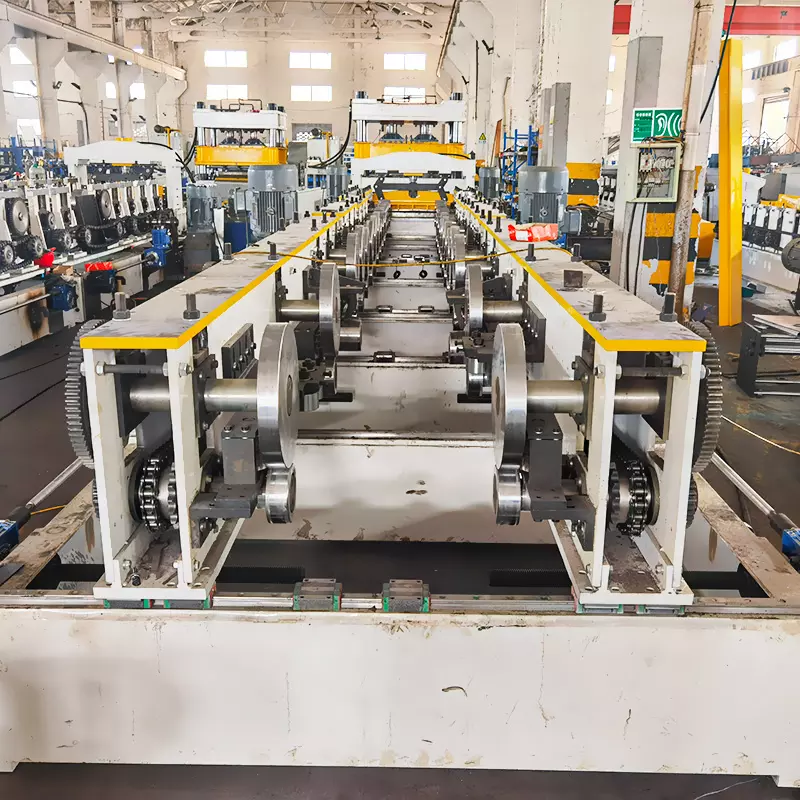Giriş
Söz konusu olduğunda metal forming, two of the most commonly used techniques are rulo şekillendirme ve pres frenleme. Both processes shape metal sheets into precise profiles, but they differ in speed, efficiency, cost, and suitability for different applications.
So, which one should you choose?
In this guide, we’ll compare roll forming vs. press braking içinde 2025, covering:
✅ How each process works
✅ Key differences in speed, cost, precision, and efficiency
✅ Best applications for each method
✅ Which industries rely on roll forming vs. press braking?
✅ Why roll forming is the preferred choice for high-volume production
Hadi dalalım!
Rulo Şekillendirmeyi Anlamak
Rulo Şekillendirme Nedir?
Roll forming is a continuous metal forming process that shapes sheet metal into long, uniform profiles using a series of roller stations. The material passes through multiple rollers that gradually shape it into the desired cross-section.
Rulo Şekillendirme Nasıl Çalışır?
| Adım | Process Description |
|---|---|
| 1. Bobin Yükleme | A metal coil is fed into the roll forming machine. |
| 2. Progressive Forming | The sheet passes through a series of rollers that gradually bend the metal into shape. |
| 3. Inline Cutting & Punching | The profile is cut to length ve punched if necessary. |
| 4. Final Inspection & Packaging | Bitmiş profiller şunlardır kalite kontrolü yapılmış ve sevkiyata hazır hale getirilmiş. |
Profesyonel ipucu: Roll forming is best for high-volume, continuous production . uniform metal profiles.
Understanding Press Braking
What is Press Braking?
Press braking is a metal bending process that uses a hidrolik or mechanical press brake to bend metal sheets into specific angles. The metal is placed between a punch and die, which exert force to form the sheet into the desired shape.
How Press Braking Works
| Adım | Process Description |
|---|---|
| 1. Sheet Placement | A flat metal sheet is positioned on the press brake. |
| 2. Die & Punch Selection | The appropriate die and punch combination is chosen for the required bend. |
| 3. Bending Process | The press brake applies force, bending the sheet into the desired angle. |
| 4. Inspection & Adjustment | The formed part is checked for accuracy and adjusted if necessary. |
Profesyonel ipucu: Press braking is best for low-volume production ve custom one-off bends.

Roll Forming vs. Press Braking: Key Differences
| Özellik | Rulo Şekillendirme | Basın Freni |
|---|---|---|
| Üretim Hızı | Continuous, high-speed production (up to 50m/dak) | Daha yavaş, parti bazlı üretim |
| İçin en iyisi | Yüksek hacimli üretim . uniform profiles | Low-volume, custom bends |
| Kalıp Maliyeti | Higher initial tooling cost but lower per-unit cost | Lower tooling cost but higher per-unit cost |
| Esneklik | Limited to pre-designed profiles | Highly flexible for custom bends |
| Precision & Tolerance | Highly precise, minimal distortion in long profiles | Good for shorter sections, but less accurate for long profiles |
| Malzeme Atıkları | Minimal waste due to continuous process | More waste due to trial-and-error adjustments |
| Otomasyon | Fully automated with inline cutting, punching, and welding | Gerekli manuel ayarlamalar |
| Labor Intensity | Low labor requirement | High labor requirement |
Karar:
- Roll forming is better for large-scale industrial production where speed, consistency, and cost-efficiency matter.
- Press braking is better for custom, small-batch, or prototype production where flexibility is required.
When to Use Roll Forming vs. Press Braking
Roll Forming is Best For:
✅ Yüksek hacimli üretim (e.g., automotive, construction, solar industries)
✅ Long, uniform profiles (e.g., C & Z purlins, metal roofing, highway guardrails)
✅ Reducing material waste and labor costs
✅ Achieving high precision with minimal distortion
Press Braking is Best For:
✅ Low-volume, custom jobs (e.g., small fabrication shops, prototyping)
✅ Short-length metal components that require angular bends
✅ Quick setup with minimal tooling costs
If you need high-speed, cost-efficient production, go with roll forming. If you need flexibility for low-volume jobs, press braking is the better choice.
Industries That Use Roll Forming vs. Press Braking
| Endüstri | Rulo Şekillendirme | Basın Freni |
|---|---|---|
| Otomotiv | Structural components, crash-resistant beams | Custom brackets, low-volume parts |
| İnşaat | Metal roofing, wall panels, purlins | Custom trim, window frames |
| Raf ve Raflar | Warehouse storage racks, uprights, beams | Custom shelf brackets |
| Güneş Enerjisi | PV mounting structures, solar panel frames | Small mounting brackets |
| Havacılık ve Uzay | High-strength structural components | Custom one-off parts |
Profesyonel ipucu: Roll forming is widely used in industries requiring mass production, while press braking serves more niche, low-volume applications.
Why Roll Forming is the Future of Metal Forming
As industries move towards automation, efficiency, and cost reduction, roll forming is becoming the preferred choice for large-scale manufacturers.
Advantages of Roll Forming Over Press Braking
✅ 50% faster production speeds
✅ 70% lower labor costs due to automation
✅ Minimum malzeme israfı
✅ Inline processing reduces post-production work
✅ Perfect for industries with high-volume needs
Looking for a high-speed, precision roll forming machine? Sunway Makine teklifler son teknoloji̇ rulo şeki̇llendi̇rme çözümleri̇ için küresel üreti̇ci̇ler.
Common Problems & Solutions in Roll Forming vs. Press Braking
Hatta advanced roll forming and press braking technologies, manufacturers may encounter challenges such as material deformation, misalignment, and production inefficiencies. Bu sorunların ele alınması erken sağlar consistent quality, reduced downtime, and improved efficiency.
Troubleshooting Guide for Roll Forming vs. Press Braking
| Sorun | Roll Forming Cause & Solution | Press Braking Cause & Solution |
|---|---|---|
| Profil Bozulması | Misaligned rollers, incorrect pressure settings → Recalibrate rollers and adjust forming pressure | Incorrect punch and die selection → Use properly matched punch and die |
| Material Wrinkling | Uneven material feeding → Ensure uniform material tension and adjust guide rolls | Over-bending of the sheet → Reduce bending force or adjust die clearance |
| Tutarsız Boyutlar | Roller wear or incorrect CNC settings → Inspect rollers and recalibrate CNC programs | Manual setup errors → Use automated press brakes for higher accuracy |
| Yüzey Çizikleri | Dirty rollers or improper lubrication → Clean rollers and apply anti-scratch coatings | Poor-quality punch/die or excessive force → Use high-precision tools and adjust force settings |
| Yavaş Üretim Hızı | Overloaded machine or incorrect material thickness → Optimize material input and machine settings | Manual bending sequence errors → Use CNC-controlled press brakes |
Profesyonel ipucu: Düzenli machine calibration and preventive maintenance olabilir reduce errors by up to 60% ve increase production efficiency significantly.
Future Trends in Roll Forming & Press Braking (2025 & Beyond)
Bu metal forming industry is evolving rapidly, with automation, AI, and sustainability geleceği̇ni̇ şeki̇llendi̇rmek roll forming and press braking technologies.
Key Innovations for 2025
1. AI-Powered Quality Monitoring
- AI-driven gerçek zamanlı kusur tespiti improves quality control.
- Reduces material waste and ensures consistent accuracy.
2. IoT Özellikli Akıllı Fabrikalar
- Machines are now integrated with bulut tabanlı izleme, etkinleştirme uzaktan tanılama ve kestirimci bakım.
- Geliştirir üretim takibi ve operasyonel verimlilik.
3. Servo-Driven Press Brakes & Roll Forming Machines
- Geliştirir hız kontrolü, hassasiyet ve enerji verimliliği.
- Azaltır mekanik bileşenlerde aşınma ve yıpranmamakine ömrünü uzatır.
4. Tam Otomatik Profil Ayarlamaları
- Ortadan kaldırır manuel ayarlamalar farklı profiller arasında geçiş yaparken.
- CNC kontrollü otomatik profil değiştirme arıza süresini azaltır ve verimliliği artırır.
Upgrading to AI-powered roll forming and press braking technologies can increase production efficiency by up to 50%!

Automation in Roll Forming vs. Press Braking
Otomasyon devrim yaratan roll forming and press braking, making them daha akıllı, daha hızlı ve daha uygun maliyetli.
Comparison of Automation Features in Roll Forming & Press Braking
| Automation Feature | Rulo Şekillendirme | Basın Freni |
|---|---|---|
| CNC & PLC Control | Ensures precise profile formation with minimal waste | Fully automated bending sequences for accuracy |
| Yapay Zeka Tabanlı Hata Tespiti | Identifies defects in real-time, reducing material waste | Detects bending errors and corrects force distribution |
| IoT & Uzaktan İzleme | Allows manufacturers to track machine performance remotely | Enables predictive maintenance and operational tracking |
| Otomatik Profil Değiştirme | Profiller arasında geçiş yaparken kesinti süresini azaltır | CNC-controlled punch and die selection for multi-bend jobs |
| Energy-Efficient Motors | İşletme maliyetlerini düşürür ve sürdürülebilirliği artırır | Servo-driven systems enhance accuracy and speed |
Tam otomatik rulo şekillendirme makineleri Sunway Makine kadar üretim verimliliğini artırmak 40%!
Essential Maintenance Tips for Roll Forming & Press Braking Machines
Uygun Bakım sağlar uzatılmış makine ömrü ve tutarlı üretim kalitesi.
Maintenance Checklist for Roll Forming & Press Braking Machines
| Görev | Frekans | Amaç |
|---|---|---|
| Makaraları ve Yatakları Yağlayın | Haftalık | Aşınma ve yıpranmayı önler |
| Check Roller & Die Alignment | Aylık | Doğru profil üretimini sağlar |
| Inspect Cutting & Bending Mechanism | Üç Aylık | Prevents defective cuts, bends, and misalignment |
| Temiz Makine Bileşenleri | Günlük | Performansı etkileyebilecek toz ve kalıntıları temizler |
| Yazılım Güncelleme ve Kalibrasyon | Altı ayda bir | Otomasyon fonksiyonlarının optimize edilmesini sağlar |
Profesyonel ipucu: Planlı bakım şunları yapabilir 50% ile makine ömrünü uzatın ve 70% ile arızaları azaltın.
FAQ: Roll Forming vs. Press Braking
1. Which method is better for high-volume production?
- Roll forming is superior for high-volume production nedeniyle continuous process and automation capabilities.
- Press braking is better for low-volume or custom jobs that require manual flexibility.
2. Is roll forming or press braking more cost-effective?
- Roll forming has a higher initial tooling cost but a lower per-unit cost, making it more cost-effective for large-scale production.
- Press braking has lower initial costs but higher labor expenses and slower production rates, making it less efficient for mass production.
3. Which method produces more precise parts?
- Roll forming ensures higher precision for long, uniform profiles.
- Press braking is more precise for small, angular bends but can have variations in long sections.
4. Can roll forming replace press braking entirely?
- Hayır, because some industries require custom bends and low-volume production, which press braking handles better.
- However, roll forming is preferred for most industrial applications where uniformity and speed are critical.
5. What materials can be used in both methods?
- Both roll forming and press braking support steel, aluminum, stainless steel, and titanium.
- Roll forming is better for thinner materialsise press braking is ideal for thicker sheets.
6. Where can I buy a high-quality roll forming machine?
İçin özel yapım, yüksek hızlı rulo şekillendirme makineleri, ziyaret edin WUXI SUNWAY MAKİNA A.Ş., LTD.
Son Düşünceler
Her ikisi de rulo şekillendirme ve pres frenleme have their advantages, but if you’re looking for high-speed, cost-efficient, large-scale production, roll forming is the superior choice.
WUXI SUNWAY MAKİNA A.Ş., LTD bir lider küresel üretici . özel yapim rulo şeki̇llendi̇rme maki̇neleri̇, teklif ileri teknoloji, uzman desteği ve rekabetçi fiyatlandırma.
İstiyorum yüksek kaliteli rulo şekillendirme makinesi? Bugün bize ulaşın!
